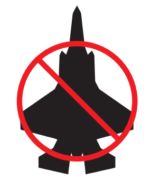The vast majority of military emissions come from operations—moving people and things around. The workhorse equipment needed to accomplish this task, particularly when it’s built to withstand combat, can be notoriously inefficient, Crawford’s report notes. Even nonarmored vehicles guzzle gas: A Humvee gets between four and eight miles per gallon. But by far, the most fuel-thirsty equipment in the military is aircraft. In fact, of the 100 million gallons of fuel the Defense Logistics Agency bought in 2018, about 70 million gallons were jet fuel.
But the United States’ reporting of military fuel consumption omits much of the fuel used to power aircraft and ships, particularly those operating overseas. The government’s own description of how it calculates international military transportation fuel for greenhouse gas emissions specifies that all Army and most Marine Corps fuel, and any fuel delivered outside of the United States, not be counted. This leads to huge gaps in reporting, Crawford says.
“You have to count it,” Crawford says. “Jet fuel is the biggest greenhouse gas from the military.”
Take the F-35, DOD’s controversial replacement for the F-16. The new plane burns more fuel than its predecessor: about 5,600 liters of fuel per hour, versus 3,500 liters per hour for the F-16, according to the newspaper Dagsavisen in Norway, where environmentalists have protested the purchase of the planes. Crawford calculated that the Air Force’s version of the plane, the F-35A, gets about 2.37 gallons per nautical mile. Note that’s not miles per gallon—that’s 2.37 gallons of fuel burned for every mile traveled. On a single tank of gas, one plane can produce almost 28 metric tons of carbon dioxide equivalent. The United States plans to buy close to 2,500 of the planes, with the expectation that they’ll fly until at least 2070.
Military equipment is purchased with the understanding that it will be around for a long time, which critics argue contributes to the difficulty of reducing military emissions.
“They can’t just switch off [the F-35 program],” says Oliver Belcher, a professor at Durham University who has studied military emissions by tracking Defense Logistics Agency fuel purchases. “Despite these sort of pronouncements to green the military and all the rest of it, every major weapon system developed, from fighter jets to aircraft carriers to you name it, is extremely carbon-intensive. … Weapons systems lock in certain carbon-intensive technologies.”
Part of the difficulty in tracking military emissions is there are so many moving parts. A military is a sprawling, bureaucratic apparatus, with people and things constantly going in different directions.
“When you’re in a theater of operations, there isn’t somebody there who’s accounting for every single bit of, this Humvee goes here, and that Humvee goes there,” Belcher says. “[It’s] extremely difficult to keep track of.”
Belcher’s research works to develop better methodologies for tracking and estimating military emissions. He’s not the only one. Last summer, in its climate change action plan, NATO announced that for the first time, it would develop a way to help member states calculate their military emissions. It also floated the possibility of helping member nations develop targets for military emissions reductions—though it noted that any reduction targets would be voluntary.
Weir was skeptical that the plan will include comprehensive emissions accounting. But, he says, any mention of reducing military emissions is welcome progress. “The fact is it’s on the agenda. It’s being talked about.”
Militaries themselves are taking notice. Last month, the head of the United Kingdom’s Royal Air Force, Sir Mike Wigston, announced plans for the service to reach net-zero carbon emissions by 2040, a decade earlier than the United Kingdom has legally committed to reach net zero across the country. He highlighted sourcing jet fuel from more sustainable sources, like ethanol or recycled waste oil, and a zero-emissions aircraft flying by the end of the decade.
“I’ve been working on these issues for quite a long time,” Weir says. “The change in dynamic around this topic over the last 18 months has been pretty astonishing.”
In early November, Deputy Defense Secretary Kathleen Hicks said President Joe Biden’s goal of reaching net-zero greenhouse gas emissions by 2050 would affect the Defense Department. “The department is committed to meeting the challenge, by making significant changes in our use of energy and increasing our investments in clean energy technology,” she said. Hicks highlighted a more sustainable supply chain, as well as a zero-emissions nontactical vehicle fleet and hybrid-electric tactical vehicles, as among the department’s goals. “As a nation and a department, we must do our part to mitigate climate change itself.”
At the beginning of November, as world leaders met in Glasgow for the COP26 climate summit, Crawford, Belcher, Weir, and Cottrell, along with other academics and activists, gathered in an Arctic basecamp tent in the city for a panel discussion on the state of military emissions and to launch a new website dedicated to corralling disparate emissions reporting. The site pulls government reporting on countries’ military emissions, as well as data like gross domestic product and military expenditure, into one database to make comparisons between countries easier and to show more clearly the state of reporting.
Although military emissions were not on the formal agenda at the United Nations meeting, more than 200 civil society organizations, including Amnesty International and Human Rights Watch, signed on to the Conflict and Environment Observatory’s call for governments to commit to meaningful emissions reductions ahead of the summit. During protests at COP26, climate activists called out the U.S. military specifically for its role in climate change.
“Not only have Western-induced wars led to the spikes in the carbon emissions, they have led to use of depleted uranium and they have caused poisoning of air and water,” Ayisha Siddiqa, a Pakistani climate activist, told a crowd during a youth protest.
“What we’re trying to do at COP26 is really get this on the agenda for COP27,” Belcher says.
Belcher and Crawford say the military is taking the threat of climate change seriously, and they acknowledge some of its green initiatives. But they argue that in the absence of reporting requirements, there’s a lack of real accountability. That makes it easy to avoid confronting some of the tougher questions about military operations and climate change—things like continued investment in carbon-intensive technologies, or “national security” as an automatic trump card.
But in the face of a global crisis, not thinking through those trade-offs head-on is a mistake, Crawford says. “You have to start questioning everything,” she says. “We don’t have time to have unquestioned assumptions.”
This War Horse feature was reported by Sonner Kehrt, edited by Kelly Kennedy, fact-checked by Ben Kalin, and copy-edited by Mitchell Hansen-Dewar. Kehrt is based in California. Her work has appeared in The New York Times, Wired Magazine, The Verge, and other publications. She studied government at the U.S. Coast Guard Academy and served for five years as a Coast Guard officer before earning a master’s in democracy studies from Georgetown University and a master’s of journalism degree from UC Berkeley.













